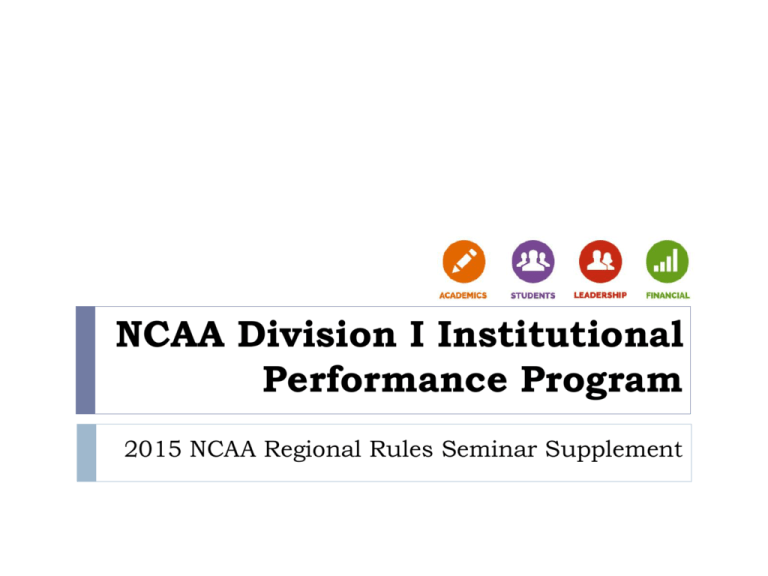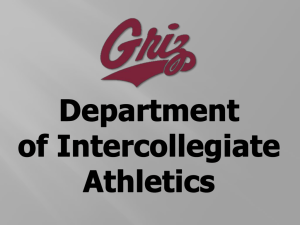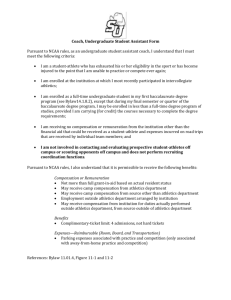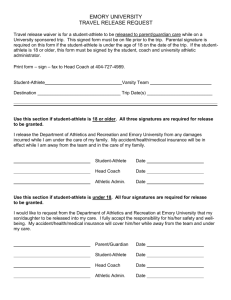NCAA Division I Institutional Performance Program
advertisement

NCAA Division I Institutional Performance Program 2015 NCAA Regional Rules Seminar Supplement Student-Athlete Experience Student-Athlete Experience Subcommittee composition. President. Faculty athletics representative. Senior woman administrator. Associate director of athletics. Former football student-athlete. Two potential components for future inclusion into the NCAA Division I Institutional Performance Program. Health and safety survey. Student-athlete experience survey. Health and Safety Survey Initially began with two distinct surveys. Health and safety; and Equipment. After 45 campus visits to receive feedback, one health and safety survey was developed that encompassed the area of equipment. Health and Safety Survey (cont.) Voluntary survey was sent to all NCAA Division I head athletic trainers November 2014. 161 respondents (47% of membership). Cross-functional advisory team. Put together at request of NCAA Chief Medical Officer. Team physicians, certified athletic trainers, practitioners in the field. Health and Safety Survey (cont.) Several entities reviewed survey before piloted. Cross-functional advisory team; NCAA Sport Science Institute; and NCAA Committee on Competitive Safeguards and Medical Aspects of Sports. Goal of survey to generate insights into the quality and effectiveness of sports medicine services. Health and Safety Survey (cont.) Specifically, the survey looks at: Physician and other medical services; Administration and management of the sports medicine area on campus; Facilities; Medical documentation; Emergency care; Mental health; Concussions; Nutrition; and Equipment. Health and Safety Survey (cont.) Key findings indicate: There is an average of four team physicians per school. There is an average of seven certified athletic trainers per athletics department. 95% of respondents indicated the team physician is ultimately responsible for the clearance to participate and the return-to-play decisions for the institution’s studentathletes. Health and Safety Survey (cont.) Key findings indicate: There is an average of two full-service athletic training clinics that exist on campus. 60% of respondents indicated the athletics department's Emergency Action Plan does not contain a plan for a mass casualty event (e.g., facility collapse; domestic terrorism) at an athletics contest. 80% of respondents indicated the department of athletics or the institution has the full-time services of a clinical mental health professional dedicated solely to student-athletes. Health and Safety Survey (cont.) Key findings indicate: Only 72% of respondents indicated that formal, written policies and/or procedures exist at their institution to facilitate the return of a concussed student-athlete to the classroom. 99% of respondents indicated their institution has a formalized process to ensure that a student-athlete who is exhibiting signs, symptoms and behaviors consistent with a concussion is removed from activity and evaluated by a medical staff member. Health and Safety Survey (cont.) Data collected in this survey cannot be found elsewhere in the medical community. Has the potential to be extremely helpful to health care practitioners and institutional leaders. Student-Athlete Experience Survey Initially began with two distinct surveys. Student-athlete experience; and Life Skills. After 45 campus visits to receive feedback, one survey was developed that encompassed the area of Life Skills. Student-Athlete Experience Survey (cont.) The voluntary student-athlete experience survey was sent December 2014 to 32 institutions that agreed to participate. Over 3,000 Division I student-athletes completed the survey late February 2015. Student-Athlete Experience Survey (cont.) Specifically, the survey looks at: Demographics; The overall college experience; Team culture; Academic experience; Student-athlete development; Time demands; Facilities; Equity and inclusion; and Health and safety. Student-Athlete Experience Survey (cont.) 76% of respondents indicated they were “very satisfied” or “satisfied” with their sport team’s culture, as compared to 11% who were “dissatisfied” or “very dissatisfied.” 92% of respondents indicated they were “very satisfied” or “satisfied” with their choice of academic major and 82% stated their athletics participation has not prevented them from majoring in what they really want. 82% of respondents indicated the faculty at their institution is respectful of student-athletes’ athletics obligations. Student-Athlete Experience Survey (cont.) The top five areas in which student-athletes would like to receive more programming are: Career development internship/job placement; Nutrition; Career development guidance; Leadership; and Personal growth and professional development. Programming for drugs/alcohol, gambling and diversity/inclusion training were the lowest ranked areas. Student-Athlete Experience Survey (cont.) Only 49% of respondents indicated the athletics department values their team as much as any other team on campus. Perceived hierarchy of sports at an institution. Helpful information to know annually for sport administrators. Questions and answers related to transportation, lodging and meals for practice and competition may not be significant nationally, but the value lies in where each school differs and how this trends over time. Rules Compliance Evaluation The NCAA Division I Committee on Institutional Performance discussed the possibility of including a oncein-four-years rules compliance review as a best practice within IPP. Committee is engaged with the National Association for Athletics Compliance and the Collegiate Commissioners Association Compliance Administrators groups to develop this best practice. Will be provided to membership after the committee’s July 2015 meeting. Academic Support Services Evaluation Academics Subcommittee recommended receiving feedback from the following groups regarding whether an academic support services review should be a required element of IPP: NCAA Division I Committee on Academics; NCAA Division I Council; Faculty Athletics Representatives Association; and National Association of Academic Advisors for Athletics. Inclusion Review Review of data included within this category should not serve as a Title IX review for Division I institutions. Data should be used to provide insight into gender equity, recognizing that additional questions and information is needed. Once-in-four-years inclusion review as best practice.


